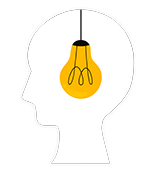Think back to your most daunting professional challenges. How many times have you thought, “If I had known how hard this would be, I might never have tried it”? While that realization might sound discouraging, it’s actually a sign of something powerful: You’re building what I call your “inventory of courage.”
Every time we tackle something that initially excited us, only to discover halfway through that it’s far more challenging than we imagined, we add another entry to this invaluable personal repository. This inventory becomes our secret weapon in future creative endeavors, especially when we face moments of uncertainty or self-doubt.
The heart of creativity is courage
It’s fitting that the word “courage” comes from the French word “coeur,” meaning heart. Because at its core, creativity isn’t just about having good ideas — it’s about having the courage to execute them. The reason many people don’t self-identify as creative isn’t a lack of imagination; it’s because creativity demands a willingness to sit with the discomfort of uncertainty. It requires what I call “the rigor of ambiguity.”
This explains why the most successful creative professionals consistently pursue projects that make them feel both terrified and exhilarated in equal measure. That 50-50 split between fear and excitement is the sweet spot where your inventory of courage grows the most.
Your inventory of courage often begins in surprising places, usually when you’re too young to edit yourself or second-guess your actions. My own journey started in first grade on a Philadelphia playground, when I confronted a bully who had cut in front of me in line. When she challenged me with “What are you going to do about it?”, I did something completely unexpected: I literally kicked her behind. While I don’t endorse this particular approach today, that moment became the seed of my inventory of courage.
This seemingly small act of standing up for myself cascaded into larger acts of courage throughout my life: navigating racial hostility at my next school, adapting to the challenging culture of a private prep school, launching an (admittedly unprofitable) hat design business in my twenties, pursuing a Ph.D. while working full-time, and eventually leaving a 16-year career in academia to become an entrepreneur.
Failure: The hidden gem in your inventory
When we talk about failure in professional settings, it often comes across as humble-bragging, like lamenting a $25 million fundraising round that “only” reached $7 million. But real failure — the kind that makes your stomach churn and keeps you up at night — is actually the most valuable entry in your inventory of courage.
As Dame Helen Mirren once noted, it’s our failures, not our successes, that spur the most significant growth. While wins provide the momentum to keep going, it’s the reframed failures that create exponential, life-changing development. Each failure, when properly processed and documented, becomes a precious gem in your inventory of courage.
The inventory of courage: A tool for team success
This concept isn’t limited to individual growth — it can transform entire teams and organizations. Here’s how to start:
- Create reflection spaces where team members can safely share their “courage origins” — those early experiences that shaped their willingness to take risks.
- Document both successes and failures, but pay special attention to how failures led to unexpected growth opportunities.
- Encourage team members to pursue projects where they feel that critical 50-50 split between terror and exhilaration.
- Regular inventory-taking sessions can help teams recognize their collective courage and build on past experiences.
The power of backcasting
The true value of your inventory of courage reveals itself when you take time to reflect. Don’t be surprised if your most significant acts of courage trace back to moments when you were too inexperienced to know better — when you simply acted because something needed to be done.
These memories aren’t just nostalgia; they’re proof of your capacity for courage. Each time you face a new challenge, your inventory reminds you: You’ve been brave before, and you can be brave again.
Remember, creativity isn’t for the faint of heart. But with a well-maintained inventory of courage, you’ll have the emotional resources to tackle whatever challenges come your way. The next time you face a daunting creative challenge, take a moment to review your inventory. You might be surprised by how much courage you’ve already accumulated — and how much more you’re capable of.
Natalie Nixon, Ph.D., is the CEO at Figure 8 Thinking and the author of The Creativity Leap: Unleash Curiosity, Improvisation and Intuition at Work.













